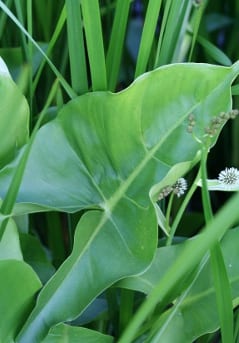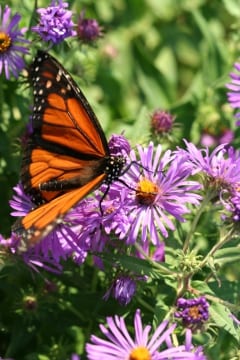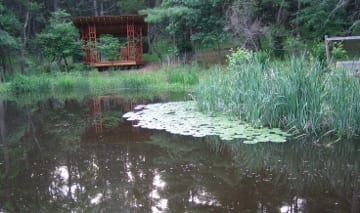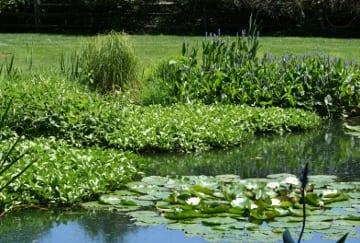by John Mark Courtney
Plants are a key element to a balanced pond ecosystem. No matter how big or small the body of water may be, plants play an essential role in maintaining good water quality and a healthy balanced habitat. Some of the functions plants perform include bank and soil stabilization, nutrient uptake from the water column, and habitat for everything from beneficial microbes, insects, fish, and amphibians to ducks, small mammals, and song birds. Plants also provide us with visual aesthetics with showy flowers and blocks of texture and color throughout the seasons.
For inspiration, look to natural ponds and lakeshores. Take note of natural meanders, curvilinear lines, and subtle transitions. Observe interactions between plant grouping and their dispersal. With a keen eye you will notice the influence of seasonal high and low water on the various plants and where they occur.
It is important to not box a design in and focus on only what will grow in the water. A full encompassing design begins well above the water and takes into consideration every step of hydrological influence approaching the waters’ edge and into the pond down three feet. Each zone plays an important role in the fabric of a healthy pond.
Zonation of Aquatic Plants
Perhaps the most overlooked and under appreciated zone around a pond is the High Meadow. This is the “buffer zone,” the first area where runoff must flow through to reach the pond. For this zone to function as part of the whole, taller grasses, some trees and shrubs would be recommended. More often than not this area is mowed turf grass, essentially rendering it non-existent. It is in this zone runoff water will be slowed down and sediments and debris will be trapped before reaching the pond.
Wet Meadow/Saturated Soil
The wet meadow or high marsh zone around a pond functions as a buffer much like the high meadow zone, but is hydrologically influenced during times of flooding or seasonally high water. The soils in the zone tend to be saturated for part of the year and support more traditional wetland vegetation and moisture loving wildflowers.
Marginal Aquatic Vegetation/Low Marsh 0-6’’
 Enter the zone where the water meets the land. This is a dynamic area that is very sensitive to erosion from wave action, foot traffic, and grazing. It is here aquatic perennials such as sedges (Carex sp.), Soft rush (Juncus effusus), Swamp rose mallow (Hibiscus moscheutos), and Blueflag Iris (Iris vericolor) work to stabilize the bank and provide cover for amphibians and small fish.
Enter the zone where the water meets the land. This is a dynamic area that is very sensitive to erosion from wave action, foot traffic, and grazing. It is here aquatic perennials such as sedges (Carex sp.), Soft rush (Juncus effusus), Swamp rose mallow (Hibiscus moscheutos), and Blueflag Iris (Iris vericolor) work to stabilize the bank and provide cover for amphibians and small fish.
Emergent Aquatic Vegetation/Shallow Water 6-12”
 The shallow water zone is teeming with abundant aquatic life like spawning fish, toads, and frogs as well as dragonfly larvae and other macro invertebrates. The plants that occupy this zone tend to be colonizers spreading with modified roots called rhizomes. Examples of colonizing perennials include Pickerel rush (Pontideria cordata), Bull rushes (Schoenoplectus sp.), Lizard’s tail (Saururus cernuus), and Burreed (Sparganium sp.).
The shallow water zone is teeming with abundant aquatic life like spawning fish, toads, and frogs as well as dragonfly larvae and other macro invertebrates. The plants that occupy this zone tend to be colonizers spreading with modified roots called rhizomes. Examples of colonizing perennials include Pickerel rush (Pontideria cordata), Bull rushes (Schoenoplectus sp.), Lizard’s tail (Saururus cernuus), and Burreed (Sparganium sp.).
 A few clump-forming perennials that occupy this zone and spread only by seed include Arrow arum (Peltandra virginica), Golden club (Orontium aquaticum), and Water plantain (Alissma sp.). These plants help break up wave action before waves can reach the marginal zone, provide excellent cover for wildlife, and aid in nutrient uptake from the water column.
A few clump-forming perennials that occupy this zone and spread only by seed include Arrow arum (Peltandra virginica), Golden club (Orontium aquaticum), and Water plantain (Alissma sp.). These plants help break up wave action before waves can reach the marginal zone, provide excellent cover for wildlife, and aid in nutrient uptake from the water column.
Floating Leaf Aquatics/Open Water 12-24”
These are the true aquatic plants. The Water lily (Nymphaea odorata), American Lotus (Nelumbo lutea), and Spadderdock (Nuphar lutea) all emerge from the bottom sediments with a petiole stretched to the surface leaves. These plants provide essential shade and cover for deeper water where algae and other potentially undesirable species would otherwise dominate.
Submergent Aquatic Vegetation/Open Water 24-36”
Submergent aquatics (SA) form the foundation of a balanced aquatic ecosystem providing a vital roll in nutrient absorption, particulate filtration, and oxygenation. They function as a biological particulate and chemical filter while providing critical cover and oxygen for countless invertebrates and the predators that consume them. Often referred to as “oxygenators,” most water gardeners consider submergent vegetation as essential for a balanced ecosystem. Many native options are available that can provide interesting forms as well as function. These include Water celery (Valisneria americana) and Floating leaf pondweed (Potomageton nodosus).
Design Process/Site Analysis
The first step to formulating a good planting plan for a pond or lake is to define the objective and primary use of the water body. A pond that is to be used for swimming will have a completely different plan from a pond that is to be used for maintaining a fishery. A good planting plan takes into consideration the primary objective and balances it with the need for aquatic vegetation to achieve a functioning healthy ecosystem.
Second, consider the entire watershed of the pond. Special attention should be paid to the primary and secondary source of water. It is in these areas that plants can be used to slow water down, trap sediments, and aid in nutrient removal before flowing water reaches the main water body. Also note the prevailing windward and leeward sides of the pond. This will help identify areas of organic deposition, as well as areas that may need plantings to help break wave action from reaching the shore. Wind can be used as a natural dispersal of seed as the plantings become mature.
Inventory existing vegetation; note non-natives, potential problem plants, as well as desirable populations that can be enhanced. Ascertain certain views and areas for access. Try to identify the seasonal high and low water line, this is especially important when planting the marginal zone where a difference of 4” of water will determine survivability of certain species.
Implementation/Planting
When planting in an earth bottom pond, use regional native plants. Most all-aquatic plants are opportunistic in nature and can be aggressive in certain situations. That’s not to say every plant has that potential, but special consideration should be taken in the plant selection.
Always work backwards in the mud to minimize foot traffic in the soft sediments, smoothing out any footprints as you go. To minimize disturbance open up the smallest hole possible to plant, unconsolidated mud cannot be compacted and should not be dug like normal garden soil. Most importantly never step at the waterline, always step over it when entering and exiting the water, this practice will help maintain the integrity of the bank.
After planting, protection from predation, up to three years, in areas of high goose pressure is a must until the plants are established. Techniques to keep the geese out range from black plastic-coated wire fencing at the shoreline and in the water to monofilament line strung across and around a pond to prevent landing. Once the plants are established and the exclosure comes down, special attention should be paid during nesting season and fall migration times. Geese can also be prevented from landing either through human harassment or canine harassment.
Following these few simple practices will help ensure the success of a shoreline planting. Remember to first lay out the primary objective and use of the water body before planting anything.
Plant Lists:
Colonizing plants for larger ponds:
Acorus americana
Decodon verticillata
Dulichium arundinacea
Menyanthies trifoliata
Pontideria cordata
Sagittaria latifolia
Saururus cernuus
Schoenoplectus sp.
Sparganium americanum
Clump forming plants for smaller ponds:
Alisma plantago-aquaticum
Carex sp.
Hibiscus moscheutos
Iris versicolor
Juncus effusus
Orontium aquaticum
Peltandra virginica
About the Author
John Mark Courtney is an award-winning designer, avid bogman, and lover of all things wild and natural. For the last 15 years John has been the greenhouse manager for Aquascapes Unlimited Inc in Pipersville, PA, where he has grown and nurtured from seed over 100 different genera of native herbaceous wetland perennials for habitat restoration. John has lectured on many topics involving ponds and bogs and has also been featured on the Martha Stewart Show. John has a BS in Environmental Design from Delaware Valley College of Science and Agriculture and interned at Bowman’s Hill Wildflower Preserve.





